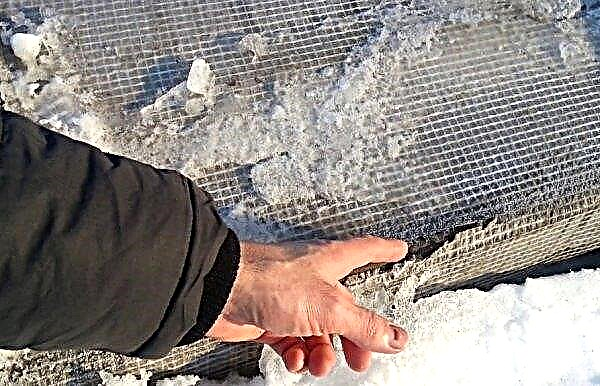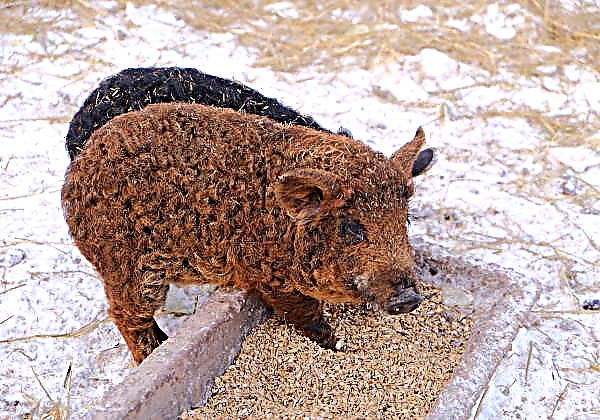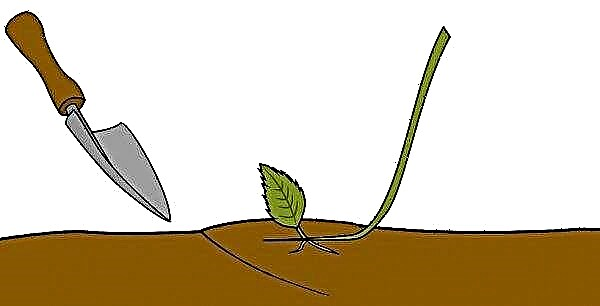With an ovoscope, you can observe the development of the embryo inside the egg. An ovoscope improves the clarity and visibility of contents. About how the device is used, and what exactly the farmer should see, we will tell in this review. You will also find information on the stages of development of poultry embryos.
What is ovoscopy?
Before laying eggs for incubation, they are transmitted through an ovoscope. The inspection process is called ovoscopy. In addition to the ovoscope, the light source may be a window, a flashlight, a lamp.
Important! At the time of laying, the chicken egg has the largest weight. Every day it dries up, so only recently taken down are taken for incubation.
An ovoscope is a small box with electric or other type of lighting. By laying an egg against a light source, you can determine if it is suitable for incubation. A light source illuminates it, and you can see not only the contents, but also defects in the shell or the air chamber, if any.

What is the procedure for?
Observation is aimed at detecting unfertilized eggs or frozen embryos. Such instances are removed from the incubator. At an early stage, before laying in the incubator, they can be replaced so that there is no empty space. This will also avoid excessive evaporation of water and eliminate the source of contamination for the contents of the incubator.
How to use an ovoscope for eggs?
The easiest way to inspect is to bring the object to a light source and look at it. A more complex design is to place a light source (bulb) under a cardboard box, in which a hole with a diameter sufficient to hold the egg is cut.

In an industrial ovoscope, a special holder is installed above the light source, with which you can view the egg, which is installed in it and rotated. You should clearly see the yolk in the center, surrounded by protein, as well as the state of the main elements: air chamber, shell.
Daily egg ovoscopy procedure
For incubation, normally developed fertilized eggs without defects are selected. Before bookmarking, they are viewed and rejected by unsuitable ones.
Perform the procedure several times:
- before bookmarking;
- at the end of the first week of development;
- at the end of the second week of development.
Important! Duck eggs stay fresh longer due to the thicker shell.
Chicken
The egg incubation process takes 21 days.

During this time, the embryo in its development goes through several stages:
- Day 1-2. The beginning of the incubation process. At this time, the laying of all organs of the embryo takes place.
- After 72 hours after the start of development, the heart even begins to beat. You can hear it if you attach a medical phonendoscope to the surface.
- 4th day. Fingers, beak, reproductive organs, wings are formed. Within 4 days you can see a dark clot inside and a network of vessels that diverge to the sides of it.
- On the 5th day upon examination, you can see the umbilical cord (allantois) of the chicken, the amniotic sac - the membrane that surrounds and protects the embryo during development. And most importantly - a small dark dot in the center of the bunch - this is the eye of the future chicken.
- 6th day. Vessels are becoming less visible. The dark spot is becoming more and more blurred, as the chicken is forming.
- Day 7-8. The content is becoming more saturated due to the many developing blood vessels. If you opened the shell at this moment, you would see that the chick appeared small feathers.
- Day 9-10. You can see the shape of the chicken.
- Day 11-15. The chick is increasing in size. In this case, the chicken is on one side and looks like a dark spot, and the opposite side looks like a bright spot.
- Day 18–20. You will not see the changes. The chicken is completing its formation. But since it occupies the entire space, you see it as a solid dark spot.
Did you know? Eggs of birds that are kept with a range are tastier and more nutritious than those obtained at the poultry farm. This is due to the fact that birds find more ingredients for their menu if they walk in the yard.
Quail
Quail can begin to appear on the 16th day of incubation, but, as a rule, this process lasts 17-20 days.

Stages of development of the embryo at different stages of development:
- 1st day. Start incubation. A small germinal disc appears - blastoderm.
- On the 2nd day there is a laying of the circulatory system.
- On the 3rd - an embryo is formed, organs are laid.
- Day 4-5. Vitellin membrane spreads over the surface of the yolk. The head and trunk are distinguishable, as well as possibly the brain. Structures of the heart appear, it begins to beat.
- 6th day. The embryo grows in size, taking the form of the letter C. Fingers form. The formation of the neck, beak continues. In the lumen, the contents look like a dark mass, consisting of a chick and many vessels.
- 7th day. The brain is developing.
- Day 8–9. The yolk is occupied by a vitellin membrane. Pigmentation of the eye is visible. The upper and lower parts of the beak are differentiated, and there are also wings and legs. The neck is stretched.
- 10th day. The membrane completely surrounds the yolk. An egg tooth is visible on the beak.
- Day 11-14th. Limbs develop. The chick is increasing in size. The eye becomes well visible. The embryo is shaped like a chicken.
- Day 15-16. Well-designed feet, there is a feather cover.
- Day 17 The protein disappears. The formation of the chicken continues, it increases in size.
- Day 18–20. The remaining yolk enters the body cavity. Chick development ends.
Important! People who don’t eat chicken eggs because of an allergy to them can replace them with ducks.
Goose
The incubation period of goose eggs takes about 30 days. Goose is larger than chicken in size. But the ovoscope should highlight them equally well.

Goose embryo development:
- 1st day - 12 hours after the start of incubation, a blastoderm begins to develop;
- 2nd day - an embryonic disk is formed that looks like a dark spot. If the stain spreads into a ring, then this is an embryo that began to develop, but died. Such specimens must be removed from the incubator;
- 3-4 days - an embryo with a vascular system is formed in the center, the formation of the head begins;
- 5th day - the embryo lengthens, after 100 hours of incubation, the future eye becomes noticeable - a dark small spot;
- 6th day - limbs are formed;
- 7–9 days - the embryo is well formed, the circulatory system develops, making the contents more intensely formed by the vessels;
- 10th day - feathers are laid;
- 11-12 days - the embryo that has got rid of the membranes is very well distinguished, it is also possible to distinguish individual parts of the body;
- 13-14 days - the embryo is shifted towards one end, the formation of organs continues;
- day 15 - the chick and its fluff continue to grow, a shaped head is visible, the protein gradually disappears;
- 16-18 days - visible embryo, covered with fluff, in a characteristic position;
- day 19 - internal organs develop, the chick is enlarged, it is already fully feathered, and transverse ridges are noticeable in the metatarsal bones;
- 20th day - the eyelid is not yet completely closed, feathers begin to pigment;
- 21-24 days - the eyelids almost closed their eyes, the protein is fully used, development continues, the beak is against the inner shell;
- day 25 - eyelids close their eyes;
- day 26 - the remains of the yolk are absorbed into the abdominal cavity;
- 27–28 days - an egg tooth pierces the membrane, and the chick switches to pulmonary respiration;
- 29-30 days - A fully formed chick hatches from an egg.
Did you know? About a quarter of all pairs of black swans — homosexuals. They steal nests or form temporary triples with females to get eggs. And then they drive her away from the nest.
Turkey
The process of hatching turkeys takes 28 days and almost repeats the development of a goose.

The incubation process can be divided into 4 stages:
- It lasts during the first week and consists in the development of the embryo and circulatory system. An increase in the dark spot (embryo) and the active development of the circulatory system are observed.
- When illuminating an egg on day 8, you should observe the separation of the contents into light and dark halves. In the dark half, an embryo is visible. In the light - a network of vessels.
- The second week (9-14 days) - the time of formation of various parts of the body from the embryo: head, neck, tail, paws. The embryo is displaced from the center and assumes a characteristic posture;
- The third week (15–25 days) is the time for the increase in the size of the chick and the final formation of all organs. In the light you see just a dark mass - this is a turkey. It occupies an increasingly large area.
- The fourth week (26–28 days) is the time of pecking. The chick is fully formed.
Ducks
Incubation of duck eggs lasts 28 days - as much as turkey eggs.

In its development, the embryo goes through the same stages:
- The beginning of embryo development (1–7 days). You see in the center a darkened area - the embryo and the blood vessels diverging to the sides.
- The formation of the skeleton and limbs (8-14 days). At this time, the size of the embryo increases, external organs form. The dark spot visible in the lumen becomes larger and darker.
- Enhanced chick formation (15-21 days). The embryo descends to the end of the egg, takes a characteristic C-shape and grows every day. Clearance at the narrow end becomes smaller, and the dark part (chick) is larger.
- The end of the formation (22–27 days). The chick is fully formed. The navel closes. The duckling pierces the inner shell and begins to breathe through the air chamber. He is almost ready to go to the surface.
- On the 28th day - the conclusion of ducklings.
Did you know? It is believed that 2 chickens can hatch from an egg with 2 yolks. But this is not true. For 2 chickens there is no room and not enough food.
Features of the procedure
Before laying in the incubator, the eggs are inspected to discard unsuitable specimens. During the incubation process, the examination is carried out 2-3 times to identify eggs with a frozen embryo and other developmental abnormalities in order to remove such an instance from the incubator in time.

Inspection Instructions:
- Hold the egg over a light source. To do this, place the blunt end directly above the source.
- Tilt it slightly to the side. Turn around.
- Look for signs that this specimen is suitable for incubation: the yolk is in the center, the air chamber of the correct form is in the blunt end, there are no shell defects, there are no blood vessels, there are no foreign inclusions.
- In the developmental stage of the embryo, the contour of the embryo and blood vessels should be visible.
- If the embryo ceases to develop, then the contents become cloudy and the blood vessels are not visible.
- An unfertilized egg does not contain signs of embryo development. It will look exactly the same as when placed in the incubator.
- If you are not sure about any of the eggs, just check it in a few days.
Video: Ovoscopy of duck and goose eggs
With normal embryo development
Inspection should show that in the first week the embryo formed and began to develop, in the second week that it increased in size, in the third week the formed chick is visible at the end of the egg, and at 4 weeks it simply develops, filling the cavity with itself.
Important! You will absorb about half the protein from an egg if you eat it raw. In other words, they are better to fry than to drink.
With pathology
If the embryo has stopped development, you will see in the light:
- the presence of blood clots;
- cloudy darkened mass instead of the embryo;
- lack of blood vessels;
- too dark an embryo that looks adherent on one side of the shell.

Inspection is carried out for 2-3 weeks, in time to notice a frozen embryo.
What defects can be detected by scrolling eggs?
Defects that can be detected by scanning at different stages will be different.
When laying for incubation, the defects are:
- the air chamber displaced from the center of the blunt end;
- an oversized air chamber is a sign of a long egg;
- the yolk is not located in the center, but is shifted in any direction;
- double yolk;
- the yolk moves when turning, not returning to its original position;
- the yolk does not move;
- there are blood clots;
- spotted shell with large pores;
- a foreign object is visible inside;
- there are darkened areas of the shell (mold pores).
Did you know? Fake chicken eggs are becoming a problem in China. They look like real ones, but are made from a mixture of resin, coagulant and starch with a coloring pigment, as well as with a fake shell. One scammer can produce up to 1,500 eggs per day.
By the end of the first week of incubation, eggs are examined to identify pathologies in the development of the embryos.
Upon examination, the following defects can be identified:
- lack of a circulatory system;
- embryonic circulatory system;
- turbid contents without signs of embryo.
 Next week, a dense large embryo will form in the egg. Vessels diverge in all directions from it. At this moment, all specimens are rejected, which instead of clear red vessels have a darkened clot. In the fourth week, the chick is gaining weight. It is clearly visible in the egg.
Next week, a dense large embryo will form in the egg. Vessels diverge in all directions from it. At this moment, all specimens are rejected, which instead of clear red vessels have a darkened clot. In the fourth week, the chick is gaining weight. It is clearly visible in the egg.
But not everyone conducts an examination at this time, since there is very little left until hatching and it is already impossible to see the pathology in the development of the chick. When examining the eggs, try not to overdo it so as not to overcool or burn them with an ovoscope lamp. If you are the first to incubate the eggs, then before you begin the inspection, view the photo to be sure which picture you should see.












